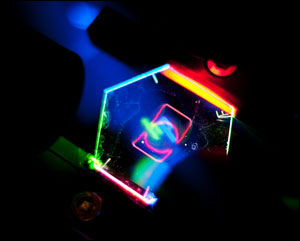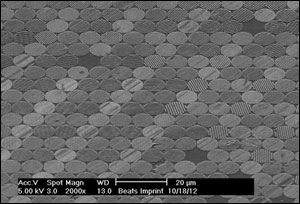By Melinda Rose, Senior Editor
PALO ALTO, Calif., March 27, 2013 — A new glasses-free 3-D display based on diffractive optics modulates at video rates and shows images that can be viewed from multiple angles even when the display is tilted, making it well suited for mobile devices.
The holographic technique developed at Hewlett-Packard Laboratories overcomes challenges faced by other devices, such as being expensive and too slow for real-time operation, by using a new backlit display with LEDs and a thin waveguide that allows pixels to produce different views and colors that can be independently modulated at video rates.
While much of the current autostereoscopic 3-D technology operates only at horizontal parallax, meaning that you see 3-D only when you move your head left or right, “We actually are talking about a technology that does 3-D for full parallax, which means that in principle you'd be able to move your head around the display, rotate your head in any direction and still see a 3-D image, much like you see in the movie Star Wars, for example ... the famous hologram of Princess Leia," said Dr. David Fattal, a researcher in HP's Information and Quantum Systems Lab, in a press briefing on the technology last week.

A 3-D image of an HP logo in RGB, from a completely transparent substrate. Courtesy of Kar Han Tan.
"One of the key factors of the technology is that it actually was designed to be very easy to animate at video rates, so we are aiming to achieve moving holograms in some way," said Fattal, an author of a paper about the work. Another important feature "is that it's compact and portable, and we think we can make it at quite low cost."
Because the display has a very wide viewing angle (up to 180° in principle), 3-D content potentially can be seen from any direction. "Which means that if you were to display a 3-D image of the planet Earth with the North Pole facing up from the screen, by turning your head around the display you'd be able to actually have a view of any country on the globe. You'd be able to see all the way around," Fattal said.
An unintentional benefit, said Dr. Raymond G. Beausoleil, who leads HP's Large-Scale Integrated Photonics research group, is that “when the display is not functioning, it looks like a piece of glass.”
“We think that even using a modulating device to achieve video rates, we can still retain most of the transparency," Fattal added.
Fattal also provided information about the lighting system needed to make the multidirectional backlight work.
"Unlike a conventional backlight, we actually need to collimate the LED before it enters the backlight, which means we need to shine mostly parallel arrays of light in the backlight for the display to work," he said. "Recently we've been using other techniques borrowed from diffracting optics, so we're able to couple most of the light [over 60 percent] from our LEDs."

A scanning electron microscope image of the backlit surface of the HP logo shown on the other picture. It shows a close-packed array of grating pixels. Courtesy of Albert Jeans.
As light propagates from one edge of the display to the next, some of it is lost. While light gradually is delivered to all the pixels, if it isn't depleted by the time it reaches the other end of the display, the extra, unused light is lost. By designing the scattering strength of the pixel grating, say by etching it more deeply, "You can make sure that at least 70 percent of the light gets used," Fattal said.
Even greater numbers could be achieved if the LEDs had a slightly narrower angular distribution. "We use very cheap LEDs right now that have a very wide angular spectrum, but maybe by spending a little bit more money, we can actually get a narrower distribution, in which case we'd be able to couple even more light," Fattal said.
Short-term uses for the technology could include low-cost 3-D signage, Beausoleil said, but “perhaps in the not-so-distant future it could make its way to smartphones, smart watches and tablets. Beyond gaming and entertainment, we believe the technology has important applications in the enterprise related to the visualization of complex data with situational awareness — like 3-D mapping, medical telepresence and surgery, and intuitive visualization of multidimensional data."
The paper, "A multi-directional backlight for a wide-angle, glasses-free three-dimensional display," appears in Nature (doi:10.1038/nature11972).
For more information, visit: www.hpl.hp.com